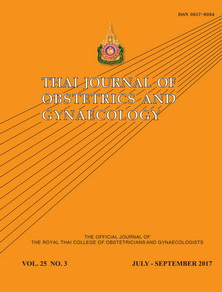Study of Delivery Forces used during a Shoulder Dystocia Simulation for 6th years Medical Students
Main Article Content
Abstract
Objectives: To describe the average force for a normal delivery and a shoulder dystocia using a force monitoring birthing simulator. We also study the influence of gender, weight, height and body mass index (BMI) on the delivery force.
Materials and Methods: After a small group teaching about managing a shoulder dystocia, consenting 6th year medical students were asked to pull on the force monitoring birthing simulator in three scenarios. Normal delivery (NL force), shoulder dystocia (SD force), and maximum force they are courage to use on a fetal head (Max force). The mean and peak force of each participant was computerized and recorded in newton (N). The effect of gender on delivery force was tested with t-test and Chi-square test. The association between weight, height, BMI, number of previous vaginal delivery and the delivery force was tested using Pearson’s correlation. A p ≤ 0.05 was considered statistically significant.
Results: A total number of 103 students participated in this study. Two were excluded due to data loss and the remaining data from 101 students were analyzed. The average force was 51.2 ±20.8 N, 83.0± 26.3 N, and 100.82 ± 34.0 N for the NL force, SD force and Max force, respectively. 84.2% of students exerted peak force of more than 100 N during a shoulder dystocia simulation. There was no effect of gender, weight, height, and BMI on the delivery force.
Conclusion: Medical students tend to use forceful traction to resolve shoulder dystocia despite the teacher verbally addressing that physicians should exert a “routine axial traction” even in the event of shoulder dystocia. A force monitoring birthing simulator may be useful in providing feedback to the students and help the students to recognize the appropriate force for delivering a shoulder dystocia. Gender and body habitus had no effect on the delivery force.
Article Details
References
2. Mehta SH, Sokol RJ. Shoulder dystocia: risk factors, predictability, and preventability. Semin perinatol 2014; 38:189-93.
3. Royal College of Obstetricians and Gynaecologists. Shoulder dystocia green-top guideline no. 42[Internet]. Second edition, London (UK); 2012[updated 2014 December; cited 2016 10 MAY]; p. 1-18. Available from: https://www.rcog.org.uk/globalassets/documents/guidelines/gtg_42.pdf.
4. Allen R, Sorab J, Gonik B. Risk factors for shoulder dystocia: an engineering study of clinician-applied forces. Obstet Gynecol 1991;77:352-5.
5. Crofts JF, Ellis D, James M, Hunt LP, Fox R, Draycott TJ. Pattern and degree of forces applied during simulation of shoulder dystocia. Am J Obstet Gynecol 2007;197: 156.e1-6.
6. Deering SH, Weeks L, Benedetti T. Evaluation of force applied during deliveries complicated by shoulder dystocia using simulation. Am J Obstet Gynecol 2011; 204:234.e1-5.
7. Crofts JF, Fox R, Ellis D, Winter C, Hinshaw K, Draycott TJ. Observations from 450 shoulder dystocia simulations: lessons for skills training. Obstet Gynecol 2008;112: 906-12.
8. Allen RH, Bankoski BR, Butzin CA, Nagey DA. Comparing clinician-applied loads for routine difficult and shoulder dystocia deliveries. Am J Obstet Gynecol 1994;171:1621-7.


